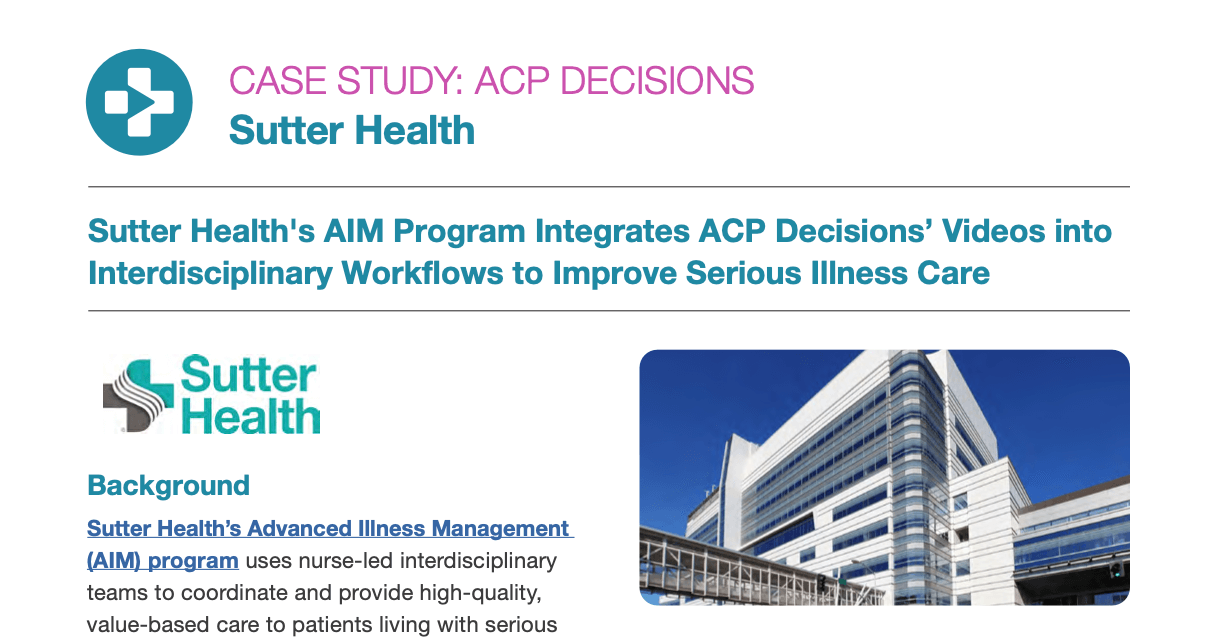IMPLEMENTATION | August 25, 2021
3 Strategies to Increase the Uptake of Advance Care Planning
Reading Time: 3 minutes

Advance care planning (ACP) allows patients to express their goals and preferences for future medical and serious illness care. Advance directives are an essential component of ACP, as they consist of the legal documents – a living will, a medical power of attorney, and Physician Orders for Life Sustaining Treatment (POLST) – that enable a patient’s wishes to be carried out if they are unable to communicate.
Despite all the evidence that proves ACP is beneficial to healthcare systems, healthcare professionals, patients, and their families, a 2017 study revealed that 63 percent of American adults had not completed an advance directive (AD).
ACP has taken on greater priority due to COVID-19. Early in the pandemic, there was a nearly five-fold increase in online ACP and AD completion. However, more recent data from the National Poll on Healthy Aging indicates that even though 59 percent of older adults have had ACP discussions, half of them have not completed any legal documentation.
With the increased awareness of ACP, it is more important than ever for healthcare providers and organizations to take steps to increase the adoption of this vital communication process. Here are three simple strategies to bolster support for ACP.
Implement a process to identify patients in need of ACP
Clinicians are busy. Time constraints and competing priorities often get in the way of ACP discussions. Every healthcare organization’s ACP initiative should include a practical process to identify patients who require ACP. This process may include:
- Routinely highlighting patients in need of an ACP intervention during daily multidisciplinary rounds
- Flagging patients in the EHR who need ACP using an AI-based algorithm or predictive model
- Designate ACP champions to promote and support adoption of the process
- Use a quality improvement method, such as Plan-Do-Study-Act (PDSA), to test the new process, facilitate implementation of the change, and create sustainable improvement
Provide access to video patient decision aids
Video decisions aids not only help overcome common barriers to shared decision making, they also offer a standardized and cost-effective means to address the communication needs around ACP. The use of video decision aids has been shown to increase the number of ACP conversations among patients with serious illness, lead to better alignment between preference for comfort-focused care and ADs, promote more informed medical decision making, and improve the rate of completed documentation preferences for medical care.
In this case study, a high acuity, multidisciplinary outpatient clinic providing care for patients diagnosed with heart failure, implemented ACP video decision aids and increased the completion of ADs from 15 percent to 54 percent.
For maximal effectiveness, visual decision aids should be chosen carefully to ensure they are high-quality, adhere to plain language principles, and are culturally relevant to the patient and their family.
Educate clinicians on how to effectively conduct ACP discussions
For most clinicians, sharing a poor prognosis and initiating a conversation about serious illness care is difficult. Given that physicians receive little to no training in medical school about how to carry out these conversations in a meaningful way, it’s little wonder they struggle with broaching the topic with patients and their families.
Education and training can instill the confidence and necessary communication skills in healthcare providers to engage in timely ACP conversations. Training opportunities could include:
- Holding expert-led communication skills workshops or webinars to help clinicians develop the communication skills for effective goals-of-care conversations
- Offering access to video-based training modules that apply to specific clinician and patient scenarios, such as these from ACP Decisions
- Providing a framework to guide clinicians during their conversations, such as SUPER or REMAP
- Helping providers facilitate ACP discussions by giving them tools to integrate patient decision aids into clinical practice and offering “lunch and learn” educational sessions to encourage the use of these tools
Is your healthcare organization interested in implementing or improving an ACP initiative? Check out these real-world case studies to see how other organizations have benefitted from using ACP Decision’s Video Library with their patients or contact us today to learn how to get started!
You might also like...

Sutter Health’s AIM Program Integrates ACP...
CASE STUDIES, IMPLEMENTATION | < 1 MIN READ


